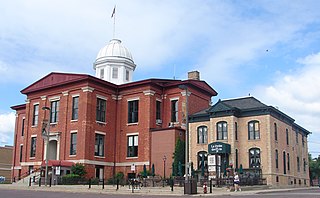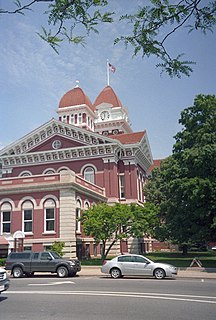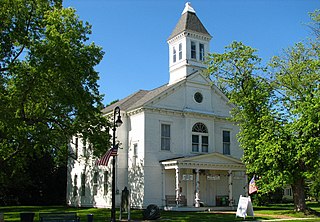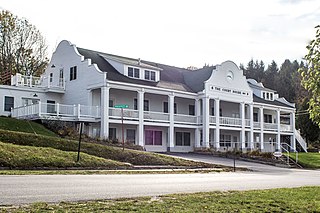
Newberry is a village and county seat of Luce County in the U.S. state of Michigan. The village is located within McMillan Township and is the only incorporated community in Luce County. The population was 1,519 at the 2010 census.

The Old McHenry County Courthouse, in McHenry County, Illinois, was listed on the National Register of Historic Places on November 1, 1974. Once the courthouse in the county seat of McHenry County, Woodstock, today the courthouse is occupied by various private tenants including a restaurant and an art gallery. It is one of the key structures in the Woodstock Square Historic District.

Tombstone Courthouse State Historic Park is a state park of Arizona in the United States. Located in Tombstone, the park preserves the original Cochise County courthouse. The two-story building, constructed in 1882 in the Victorian style, is laid out in the shape of a cross and once contained various county offices, including those of the sheriff, recorder, treasurer, and the Board of Supervisors as well as courtrooms and a jail. Inside, the courthouse contains a museum with numerous artifacts from the town's history while outside, a replica gallows has been constructed in the courtyard to mark the spot where seven men were hanged for various crimes. The park was one of the first to be designated as a state park and in 1959 was the first to open following the 1957 establishment of the Arizona State Parks Board.

The Shackelford County Courthouse Historic District is a historic district in Albany, Texas. It is roughly bounded by South 1st, South 4th, South Jacobs, and South Pecan Streets, centered on the courthouse square. Added to the National Register of Historic Places in 1976, the district includes the Shackelford County Courthouse and a number of surrounding Victorian buildings dating from the late nineteenth and early twentieth centuries.

Crown Point Courthouse Square Historic District is a historic district in Crown Point, Indiana, that dates back to 1873. It was listed on the National Register of Historic Places in 2004. Its boundaries were changed in 2005, and it was increased in 2007 to include a Moderne architecture building at 208 Main Street. The late nineteenth- and early twentieth-century commercial and public buildings represent a period of economic and political growth. The Lake County Courthouse stands in the center of the district. Designed by architect John C. Cochrane in 1878, this brick building is a combination of Romanesque Revival and Classical styles. Enlarged in 1909 with the addition of north and south wings, designed by Beers and Beers. Continued growth in the county required second enlargement in 1928. This local landmark was placed in the National Register of Historic Places in 1973.

The Genesee County Courthouse Historic District is located at the junction of Main, West Main and Ellicott streets in downtown Batavia, New York, United States. It is a small area with the county courthouse, a war memorial and other government buildings dating from the 1840s to the 1920s. Some were originally built for private purposes.

The Henry County Sheriff's Residence and Jail is a government building in Napoleon, Ohio, United States. Built in 1882 to a design by architect D.W. Gibbs, the residence-and-jail is located adjacent to the Henry County Courthouse in the city's downtown.

The Dickinson County Courthouse and Jail is an historic complex of governmental buildings located at 700 South Stephenson Avenue in Iron Mountain, Michigan. On May 15, 1980, the complex was added to the National Register of Historic Places.

The Milam County Courthouse and Jail are two separate historic county governmental buildings located diagonally opposite each other in Cameron, Milam County, Texas. The Milam County Courthouse, located at 100 South Fannin Avenue, was built in 1890–1892, while the Milam County Jail, now known as the Milam County Museum, was built in 1895. On December 20, 1977, they were added to the National Register of Historic Places as a single entry.

The Sandusky County Jail and Sheriff's House is a historic government building near downtown Fremont, Ohio, United States. Built in the early 1890s, it was used as an incarceration facility for almost a century before closing and being converted into an office building.

The Menominee County Courthouse is a government building located on Tenth Avenue between Eighth and Tenth Streets in Menominee, Michigan. It was listed on the National Register of Historic Places in 1975 and designated a Michigan State Historic Site in 1974.

The Waushara County Courthouse, Waushara County Sheriff's Residence and Jail is a pair of buildings in Wautoma, Wisconsin that are together listed on the U.S. National Register of Historic Places.

Kewaunee County Sheriff's Residence and Jail is a building in Kewaunee, Wisconsin, located at 613 Dodge Street on the southeast corner of the courthouse square. It was built in 1876 as the sheriff's office, residence, and county jail. The building was added to the National Register of Historic Places in 1996.

The Barry County Courthouse is a government building located at 220 West State Street in Hastings, Michigan. It was designated a Michigan State Historic Site in 1969 and listed on the National Register of Historic Places in 1981.

The Second Arenac County Courthouse, also known as Ye Olde Courthouse Masonic Hall and the Omer Masonic Hall, is a historic building located on Central Avenue in Omer, Michigan. The building is an outstanding example of a highly detailed vernacular frame building. It was designated a Michigan State Historic Site in 1976 and listed on the National Register of Historic Places in 1982.

The Benzie County Courthouse is a historic former courthouse in Beulah, Michigan. It is a Michigan State Historic Site and is listed on the National Register of Historic Places. Built in 1912 as a hotel and recreation center, it later served as a courthouse until 1976.

The Rockingham County Courthouse is a historic courthouse located at Wentworth, Rockingham County, North Carolina. It was designed by Frank P. Milburn and built in 1907. It is a Classical Revival style red brick building that consists of a three-story hipped roofed main block flanked by later added two-story flat roofed wings. It features a low and broad polygonal cupola atop the Spanish red tile roof. The 1907 courthouse, listed on the National Register of Historic Places in 1979, now houses the Museum and Archives of Rockingham County.

The first jail was built in 1837 of 14 inches (36 cm) square logs. It was two stories tall with a trap door from the second story floor to access the ground floor. The next jail was made of brick. Like the first jail, it was located on Courthouse Square. By 1869 this second structure was in serious need of repair. Frequent jail breaks from the second jail, led the county to hire George Garnsey of Chicago to design a new jail. The most notable jailbreak resulted when prisoners pushed bricks out of the wall.

The Appanoose County Sheriff's House and Jail is a historic structure located in Centerville, Iowa, United States. Provisions for a jail in Appanoose County were not realized until 1855 when a small stone building was constructed. It was used for about ten years when one of the inmates easily escaped.

The Old Berrien County Courthouse Complex, also known as the History Center at Courthouse Square, is a historic district located in Berrien Springs, Michigan. The complex is 1.6 acres and is home to five structures, two of which are the oldest of their kind in the state of Michigan. While the property and its buildings are owned by Berrien County and stewarded by the Berrien County Historical Association. While the historic 1839 Courthouse was added to the National Register of Historic Places in 1970, the BCHA resubmitted the application to include the remaining property added during the 1970s. The application was approve and the entire complex was added to the register 1982.



























